Text
THE Ascetic forever lost in Meditation - Lord Shiva ~cosmic Father & Guardian of the universe

WHO IS SHIVA?
RUDRASHTAKAM, AN ODE TO SHIVA, ANSWERS…
Namami-shamishannirvan roopam, vibhum vyapakam brahma-ved swaroopam. Nijam nirgunam nirvikalpam niriham chidakashmakashvasam bhajeham
Meaning:
It is the Lord, it is the most powerful, it is all over, spread everywhere. There is no place that it is not. It is that space, that consciousness where all the knowledge is present. It was never born and it has no attributes. It is a state of Samadhi where there is nothing, just the inner sky of consciousness. That is Shiva.
WHAT IS SHIVA?
‘SHIVA’ IS SAMADHI.
Shiva is beyond the sleeping, dreaming and waking states of consciousness. Shiva is samadhi - the fourth state of consciousness which is achieved through meditation. In samadhi, the mind is in total equanimity. It is peaceful and alert at the same time.
In Hinduism, Lord Shiva is regarded as the representation of the Supreme Being. He is known as the third element in the Hindu Trinity (Trimurti), the other two members being Lord Brahma - the creator and Lord Vishnu - the protector. Shiva is often shown with many faces, as creator, destroyer and preserver in total command of the cosmos. He contains both good and evil. He is moody, free of inhibitions, easy to please, protector of the down trodden, and has the power to alter the laws of destiny.
Shiva is the destructive form of the Almighty. As the cycle of destruction and recreation is always in a circle, Shiva’s primary responsibility is maintaining the life cycle. Scholars say, as the Mahakaal, Shiva destroys and dissolves everything into nothingness but as Shankara, he also reproduces that which has been destroyed and dissolved. His symbol of Lingam or the phallus represents this reproductive power.
ON the 14th day of the dark fortnight in the hindu month of Phalgun, devotee’s of this mystic lord offer ritualistic prayers through the night until dawn break . They chant hymns in his praise, offer special prayers , and meditate with utmost devotion & dedication at midnight . This auspicious night is known as ‘Mahashivaratri’ meaning -’The Great Night of Lord Shiva’. In 2020, this night falls on 21st February.This festival is celebrated for one day & one night( night is more important).AS per the Hindu Vedas, the Universal spiritual energy generated by favourable planetary positions is at it’s peak during this time.Hence, when devotee’s pray & fast during this time, it has a profound impact on their mind & body.
Hindus consider it extremely auspicious to worship Lord Shiva on a Shivaratri as it is believed that worship of Lord Shiva with devotion and sincerity absolves a devotee of past sins. The devotee reaches the abode of Lord Shanker and lives there happily. He is also liberated from the cycle of birth and death and attains moksha or salvation.
In Sadhguru Jaggi Vasudev’s own words - “ On this night, the northern hemisphere of the planet is positioned in such a way that there is a natural upsurge of energy in a human being. This is a day when nature is pushing one towards one’s spiritual peak. It is to make use of this, that in this tradition, we establish a certain festival which is night-long. One of the fundamentals of this night-long festival is to ensure that – to allow this natural upsurge of energies to find their way – you remain with your spine vertical – you stay awake.”
ACCURATE TIMINGS OF MAHASHIVARATRI (all timings are according to Indian Standard Time) :
Chaturdashi Tithi Begins - 12:50 PM on Feb 21, 2020
Chaturdashi Tithi Ends - 02:32 PM on Feb 22, 2020
Nishita Kaal Puja Time - 12:10 AM to 01:03 AM, Feb 22
Duration - 00 Hours 53 Mins
{Timings may vary according to your place of residence.For accurate timings according to your place of residence,click here - https://www.drikpanchang.com/festivals/maha-shivaratri/maha-shivaratri-date-time.html }.
55 notes
·
View notes
Text

Brahman or the Supreme Self alone is real. He is the Soul of all. He is All in all. He is the Essence of this universe. He is the Unity that never admits of a duality under all the varieties and diversities of nature. Thou art this immortal, all-pervading, all-blissful Brahman.
Thou art That-Tat Tvam Asi.
Realise this and be free.
50 notes
·
View notes
Text

{ in picture - Vamana avatar of Lord Vishnu)
O Almighty! You are the infinite; the universe is also infinite! From infinite the infinite has come out! Having taken infinite out of the infinite, the infinite remains! O Almighty! May there be Peace! Peace! Everywhere!
~ (Ishawashya Upanishad)
50 notes
·
View notes
Text
What Happen’s Next ?? ~the end of ‘KALI YUGA’.
The ‘PRESENT’ - Living in the Kali Yuga

We are said to presently be living in the Kali Yuga—in a world infested with impurities and vices. The numbers of people possessing noble virtues are diminishing day by day.
Floods and famine, war and crime, deceit, and duplicity characterize this age. But, say the scriptures, it is only in this age of critical troubles that final emancipation is possible.Kali Yuga has two phases: In the first phase, humans—having lost the knowledge of the two higher selves—possessed knowledge of the "breath body" apart from the physical self. Now during the second phase, however, even this knowledge has deserted humanity, leaving us only with the awareness of the gross physical body. This explains why humankind is now more preoccupied with the physical self than any other aspect of existence.
Due to our preoccupation with our physical bodies and our lower selves, and because of our emphasis on the pursuit of gross materialism, this age has been termed the Age of Darkness—an age when we have lost touch with our inner selves, an age of profound ignorance.
Both the two great epics—the Ramayana and Mahabharata—have spoken about the Kali Yuga. In the Tulasi Ramayana, we find the sage Kakbhushundi foretelling:
In the Kali Yuga, the hotbed of sin, men and women are all steeped in unrighteousness and act contrary to the Vedas. Every virtue had been engulfed by the sins of Kali Yuga; all good books had disappeared; impostors had promulgated a number of creeds, which they had invented out of their own wit. The people had all fallen prey to delusion and all pious acts had been swallowed by greed.
In the Mahabharata (Santi Parva), the hero Yudhishthir says:
… The ordinances of the Vedas disappear gradually in every successive age, the duties in the Kali age are entirely of another kind. It seems, therefore, that duties have been laid down for the respective age according to the powers of human beings in the respective ages.
The sage Vyasa, later on, clarifies:
In the Kali Yuga, the duties of the respective order disappear and men become afflicted by inequity.

According to Hindu cosmology, it is predicted that at the end of the Kali Yuga, Lord Shiva will destroy the universe and the physical body will undergo a great transformation. After the dissolution, Lord Brahma will recreate the universe, and humankind will become the Beings of Truth once again.
89 notes
·
View notes
Text
DURGA PUJO DATES FOR 2019 ARE ~ 3rd October to October 8th , 2019.
Celebrating Our Goddess Supreme ~The Bengali way...DURGA PUJO !

FOR 5 days every year,KOLKATA city of the Eastern state of India - West Bengal ,explodes into a frenzied whirligig of devotion, hoopla and merriment.FEMALE POWER REIGNS SUPREME AS THIS FESTIVAL CELEBRATING THE MOTHER GODDESS AS KALI,SARASWATI & LAKSHMI IS VERY BIG .This is the ‘Mother’ of all celebrations : DURGA PUJA also known as DURGA PUJO.Here’s a peek into Kolkata’s own Mardi Gras - part religious,part cultural,wholly social.This year the ‘Pujos’ are from september 26 - 30,2017.
Durga Puja the biggest festival of ‘Bengalis’ ,is also considered as one of the social events of India. It is an auspicious festival of Bengalis which is also referred as a 10 days of carnival in the state of West Bengal and eastern state of India. In Kolkata the capital city of West Bengal and other neighboring states, magnificently created puja pandals are erected and are major attraction. Magnificent Pooja Pandals are unique in terms of their materials, theme and shapes. It is truly a delight for eyes to watch such magnificent Pandals of Durga Puja and amazingly carved goddess idols. For complete 10 days of celebration, a spurt of fanfare is easily sensed and that too especially on last 5 days of the festival. Bengalis consider Durga Puja as a wonderful festival celebration to reconnect with family and friends. In fact the air gets filled with the festivity during this time of the year. Read further to know more about Durga Puja in Kolkata.
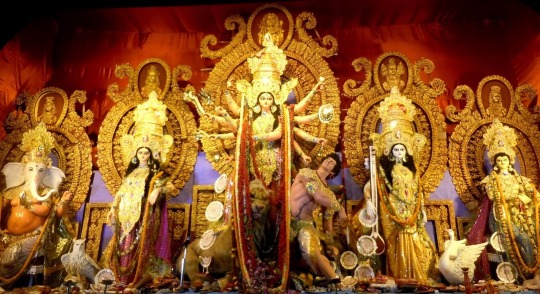
THE HISTORY BEHIND THE ‘ PUJOS ’
Since centuries, Durga Puja celebrations have been a significant affair for Bengal, however the community gatherings and para (neighbourhood) preparation dates back to 17th- 18th century A.D, when several zamindars and aristocrats would hold Lavish pujas bringing together the entire locality under one roof. For instance the Aatchala Puja in Kolkata, which was started by renowned zamindar Lakshmikanta Majumder in the year 1610 or the Shobha Bazar Choto Rajbari at 33 Raja Nabakrishna Road in Kolkata, which was initiated in the year 1757. Even outside of Bengal, the trend of hosting lavish pujas with artful Goddess Durga idol and extravagant pandals has become popular. We will now take through the Most distinct traditions of this “ GLORIOUS FESTIVAL of the Kolkata.
PART 1 ~ THE PREPARATIONS
Durga Puja festival preparations commences one or two months in prior to the celebration dates. Just like Diwali bonus offered to employees in North India, in Kolkata Puja Bonus is offered to employees of both government as well as private organizations. In fact, many Pre-pooja bargain sales are also offered by shops in Kolkata as they get huge amount of sale during the festival. The festival is in fact welcomed with great enthusiasm by every household.
PART 2 ~ THE MAKING OF THE IDOL
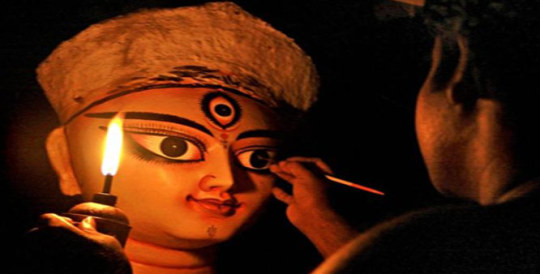
Many years back, Durga Puja festival was celebrated within the families at home and now it has turned into a community festival which is celebrated at Puja pandals. Few months prior to the festival celebration in Kumartuli which is a place near to Kolkata, amazing idols of goddess Durga are given shape. It is a famous place for production of beautiful idols of gods and goddesses. Here the expert artisans show their talent in making idols of Goddess Durga, Lord Kartikeya, Goddess Saraswati, Lord Ganesha, Goddess Lakshmi and the demon Mahisasura which are required for the festival.
PART 3 ~ THE GRAND DECORATIONS
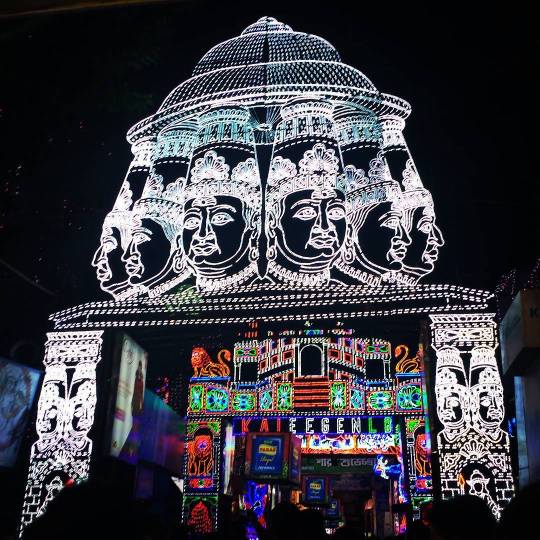
On Durga Puja, pooja pandals are the main attraction. Many people are much talented in developing Puja Pandals (huge covered stage for Puja) with use of wood, paper, bamboos, plastic materials, clothes and other amazing stuffs. Innovative ideas of making Pandal set ups and goddess idols are done with great devotion and a lot of money is erected in Puja Pandals which are all decked with mesmerizing art work. In fact many pandals are also built in shape of world famous monuments or structures.
PART 4 ~ THE CELEBRATIONS
The major days of the celebration of Durga Puja celebration are seventh, eight, ninth and the tenth day. Basically, the celebration of Durga Puja gears its pace on the 6th day of celebration that is on Maha Shashti. The major rituals of Durga Puja start on the 7th day. The priest is called upon to chant the mantras, shlokas of Puja and perform aarti at the pandal of the Puja. Moreover, there are many cultural activities held such as dance and song competitions as well as games are also organized during last few days of the festival celebration. Many professional artists like singers, dancers, musicians are also called for singing bhajan and stuti of Goddess Durga. Apart from pandal decorations, the city is also illuminated and decorated with displays of colorful and sparkling lights. Also educational institutions as well as offices are closed during four main days of Durga Puja celebration. Indeed, Durga Puja is the biggest and most cheerfully celebrated festival of Kolkata or West Bengal state generally .
HOW THE BONGS CELEBRATE NAVARATRI ~
a. The Dhunuchi Dance
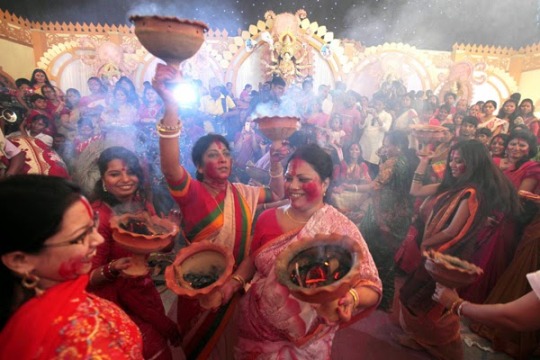
Dhunuchi Dance is called Dhunuchi because it is performed with Dhunachi . Dhunachi is a native Indian incense burner used during Aarti. The Dhunachi has a flared shape and held by a stem and it has a large cavity at the top. Dhunachi is traditionally made of earthenware so that heat is insulated from the handle and it can be hold in arms for long duration without any discomfort. Dhunachi is lit by placing burning coal at the bottom, which ignites a layer of slow-burning coconut husk, on which incense (usually camphor) is sprinkled. In Eastern India especially in West Bengal, Dhunuchi Nritya is very common during Durga Puja.Dhunuchi dance is performed with two Dhunachi in hands (with single Dhunachi in each hand) along with the frenzy beat of Bengali country drums known as Dhak. In many communities, Dhunuchi competitions are organized and some dancers perform Dhunuchi dance with as many as three Dhunachi by holding third Dhunachi between the teeth.
b. The Tradition of ‘SINDOOR KHELA’
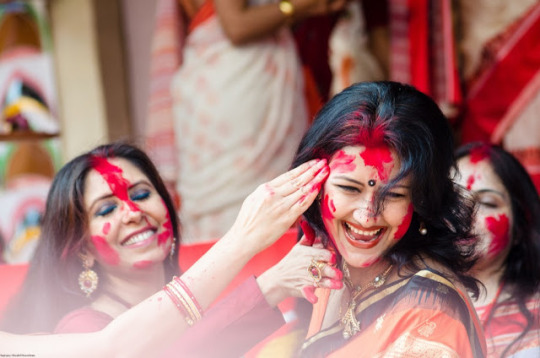
It is an age old ritual that on the day of Durga puja, women apply sindoor/sindur on the goddess’s feet or forehead and then start smearing it to all the married women around. However, unmarried women or widows are not allowed to celebrate Sindoor Khela. Sindoor Khela celebrates the pride that Bengali wives take in having a husband and to wish a long happy life of her better half. The customary “Sindoor Khela” marks the end of the biggest festival of the Bengalis. It is the time when all the actresses in Kolkata get together and splash each other with the vermilion.
c. The Durga Puja of the ‘BONEDI’ families of Kolkata
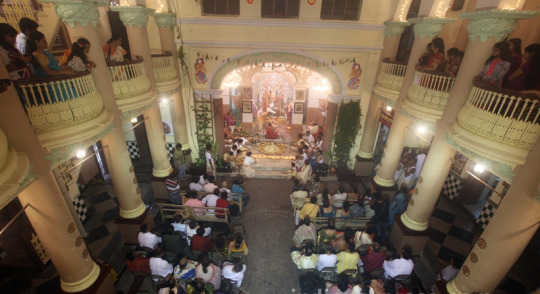
During Durga Puja festival at Bengal the star attraction are the different Barowari Pujas conducted by several clubs and associations. The themes of Pandal and idols of these pujas change every year. Latest themes of Pandals and idol are the talk of the town.Generally overlooked by the Pandal hoppers are the Durga Pujas held privately in several families some of whom were affluent and stalwarts in yesteryear, specially during the Colonial Regime. Although the financial condition is not affluent as it was in earlier days (mainly because the Zamindari system was abolished post independence), yet these families till date perform Durga Puja with dedication maintaining all the rituals. The Pujas are all of 100+ years, some even 200+ and 300+ years old. Everyone of the families gather to celebrate Durga Puja with pomp and show as an annual get-together.

On the Pooja days, devotees wake up early in the morning, and observe a fast until the Durga Anjali that takes place early in the evening around 6-6:30pm, after which they break their fasts with fruits and sweets. Soon after the cultural activities and programs kickstarts, and so does the joy of pandal hopping. With so many beautiful pandals lined up across the city, several families try to make it a point to visit as many pandals in a day as possible.The pandals are often lined with many food stalls, selling the best Kathi Rolls, kebabs, fried fish, biryani, other savoury and sweet snacks. The round of gorging on delicious food ends only on the evening of Vijay Dashami with a good serving of several Mughalai & Indian delicacies like,Mutton Biryani or some Mutton Kosha and loochi (a close cousin of poori).
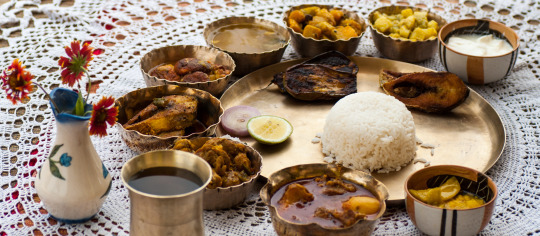
~ (The sumptuous traditional bengali Navaratri meal)
FIND BENGALI DURGA PUJO CALENDER HERE - OM SHAKTI - Om Krim Kali
May her blessings remove all obstacles from your path of life as she removes the darkness from the universe…. Happy Durga Puja
141 notes
·
View notes
Text
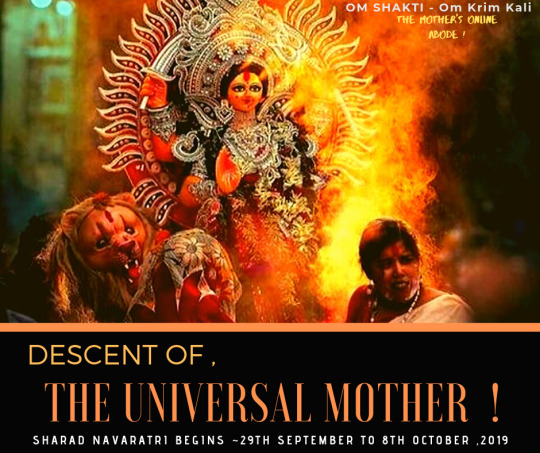
The word ‘Navratri ‘means ‘Nine Nights’ when translated literally. Navratri is one of the most important festivals celebrated by Hindus in India and across the globe . The festival is celebrated with full pomp and show that reverberates happiness. In this festival, people worship the nine different forms of the Goddess Durga who symbolizes sincerity, power, and divinity. It is the longest and the most anticipated Hindu festival of the year, crossing over nine nights and ten days.
In a whole year, Navratri comes four times-one each in the months of Chaitra, Aashadh, Ashwin, and Magha. The Navratri that comes in Chaitra or Basant months in March or April is celebrated with great vigor, however, Sharad Navratri earns the most importance.
During Navratri, the ninth day is celebrated as Ram Navami. (The birth of Shri Ram).
Goddess Shakti exists in numerous ferocious as well as Serene manifestations; hence the celebration of each day of Navratri is dedicated to each Goddess embodiment for nine sacred days. Navratri is revered to show utter devotion and respect to Goddess and thus recognized with full devotion, zeal and enthusiasm all over the country. The nine incarnations of Goddess Shakti are:
Maa Shailputri,
Maa Brahmacharini,
Maa Chandrakanta,
Maa Kushmanda,
Maa Skandmata,
Maa Katyayani,
Maa Kaalratri,
Maa Mahagauri, and
Maa Siddhidatri
Being one of the celebrated and distinguished religious occurrences for Hindu community, this festival has become the most reverenced holy occasion.Like every other Indian festival, the core message of this festival remains the same – the victory of good over evil. It is believed that Goddess Durga battled with demon Mahishasura and defeated him. It signifies the faith and belief of people in the power of the goddess and that of the divinity. To celebrate her victory and Mahishasura’s defeat, the 9 days are earmarked to worship and honor the Goddess.
Each day of Navaratri , to know the the special puja dedicated to each form of Mother Goddess ,follow us on our other page (CLICK HERE ) ~ https://www.facebook.com/adiparashakthikali/
23 notes
·
View notes
Photo

FULL ARTICLE ....COMING SOON
For more updates , follow Our facebook page dedicated exclusively to the Mother Goddess ~ Om Shakti - Om Krim Kali
8 notes
·
View notes
Text
Hinduism through ages : the timescale : the religion & it’s - ‘Yugas !’
Satya Yuga

Hindu mythology clearly states that all living beings pass through a continuous cycle of creation and destruction, the Maha Yuga. This cycle repeats itself over four different epochs or Yugas. The first of these Yugas is the Satya Yuga, which spans a period of 1,728,000 years.
The Satya Yuga is said to be the golden age of truth and enlightenment. In this age, people attained an ideal state of mind and their actions were always reasoned and virtuous. The sacred texts further state that there was a surplus flow of ideas and thoughts between people.Everyone led an honest life and adhered to the truth. Everyone had acquired the answer to the ultimate question – the origin of everything. And since there was virtually nothing to conceal, even the tiniest thread of thought was accessible to everyone without verbal communication. Human physiology also significantly differed from the one that we exhibit today. People used to be around 31.5 feet (21 cubits or 80cm) tall. They also had a lifespan that stretched over hundreds of thousands of years.
Treta Yuga

This represents the second age in the cycle of Maha Yuga. The Hindu scripts state that Treta Yuga spans a period of 1,296,000 human years.
By the advent of Treta Yuga, the presence of sattva or goodness in human nature had slowly started to diminish. Whatever goodness or virtue that remained in people was now accompanied by an ever-increasing amount of tamas and rajas. Tamas represented the darkness in human nature and rajas constituted all the passion a human could conjure. By now, people had nurtured an acute level of intellect, but they had also lost a good deal of control over their body and its physiology.People’s stature was now smaller than during the Satya Yuga, with the average human being around 14 cubits tall, but there were some exceptional beings who had attained a godly build and divine persona such as the characters Rama, Laxamana, Ravana, and Hanumana who were considered godlike for their extraordinary strength and inimitable intellect.
Dwapar Yuga

Dwapar Yuga represents the third age right after Treta Yuga. Also known as the Bronze Age, the Dwapar Yuga is said to have lasted for 864,000 human years. It represents an age where goodness and evil in human nature are neck and neck.
As the human body loses satva or purity, people attain a far greater control over their body than their intellect. By the time Dwapar Yuga was at its peak, man had already lost control over his innermost body and knowledge. He became more attracted to the materialistic aspects of the world, succumbing to his ever-increasing desires. Only intellectuals like Bhisma, Dharmaraja, and Vidura were able to escape this fate. Eventually, there was a gradual decline in the moral fiber of society in general. People with enormous physicality became increasingly offensive in their thirst for desire and power. The average human lifespan had also come down to 1,000 years.
Kali Yuga
The last age in the ever-repeating cycle of Maha Yuga is the Kali Yuga. It is also the shortest, lasting for 432,000 human years. The current time period falls under Kali Yuga, and it is also referred to as the Iron Age.
The Kali Yuga represents hypocrisy and instability like never before. Human nature is significantly corrupted by the temptations of sin and only a little conscience remains.The human body is at its lowest in terms of physicality and intellect. An average man is only 3.5 cubits tall and lives for around 100 to 120 years. Citing the ancient Hindu scripts, it is estimated that around 5,000 years of Kali Yuga have already passed by. It is also predicted that when Kali Yuga reaches its dying years, the lifespan of man will be no more than 20 years. This age has been highlighted by man’s unprecedented longing for materialism. In a stark contrast to previous ages, human lives have been corrupted by ignorance and the connection to one’s inner self has been lost.
65 notes
·
View notes
Photo

For more updates ,follow us on The Ancient Hinduism Facebook page .
11 notes
·
View notes
Text
ONAM IS HERE ! : സന്തോഷകരമായ തിരുവോണം santēāṣakaramāya tiruvoṇaṁ ~ HAPPY ONAM !
Just as the monsoon bids adieu to the land of South India, the air is filled with vigour, joy, and happiness with the arrival of Onam, a significant festival celebrated majorly in Kerala state of southern India.From the intricately decorated elephants to the wild ‘Pulikali’ dancers, and from the gigantic snake boats lined up at the shore to the gorgeous floral decorations, this festival paints the state in more colors than you can imagine.
Onam, is celebrated in order to honor King Mahabali, one of the most respected kings of the state. The entire festival is celebrated in order to welcome his spirit to the place as he is supposed to visit the state during this period. It is believed that that it was on the this day in the month of Chingam when Lord Vishnu took in avatar of ‘Vaamana’, came to the state of King Mahabali and sent him to nether world. It is said that since that day the festival of Onam is celebrated in order to memorize his wonderful reign of peace and prosperity in the kingdom.

In order to welcome their respected ruler, people lay flower mats (Pookalam) in the front courtyard, arrange grand feast (Onasadya), dance, play, and celebrate. All this is done to make the King feel that his people are still happy and prosperous. It is believed that Onam celebrations started during the Sangam period as some evidences of the celebrations related to the Kulasekhara Perumals (800 AD) have been found. It is said that during that time Onam was celebrated for a month.
The harvest festival of Onam is celebrated across India and the world by Keralites. The festival falls on the 22nd nakshatra Thiruvonam, in the Malayali calendar month of Chingam, and marks the beginning of the Malayalam (official language of the state of kerala ) calendar which is called Kolla Varsham. The festival usually falls in the months of August and September, and is spread over ten days. The festival kicks off on the day known as Atham, and culminates on the tenth day, known as Thiru Onam or Thiruvonam, which is the most auspicious day during Onam.
Onam festival date 2019 has been released by the ministry according to which the festival will be conducted from September 1 2019, to September 13, 2019. ‘THIRUVONAM’ - the main festival is celebrated tommorow - 11th sept,2019 . For accurate timitings of ‘Thiruvonam’ click here - https://www.facebook.com/ancienthinduismreligion/photos/pcb.903656313346592/903649373347286/?type=3&av=280027039042859&eav=AfbWqU5Ii_qnNGaWXuNq_2yv_mkj0NSaqH4tQjrbUQCmoM33hlkqCOYSa_eoVFAOXYU&theater
8 notes
·
View notes
Text
The hindu Aeon’s .

According to Hindu scriptures and mythology, the current universe is destined to pass through four great epochs, each of which is a complete cycle of cosmic creation and destruction. Hindu mythology deals with numbers large enough to be nearly impossible to imagine.
Hindus believe the process of creation moves in cycles and that each cycle has four great yugas, or epochs, of time. And because the process of creation is cyclical and never-ending, it "begins to end and ends to begin."
A Kalpa, or eon, is said to be comprised of a thousand cycles of four yugas—each of a different quality. By one estimate, a single yuga cycle is said to be 4.32 million years, and a Kalpa is said to consist of 4.32 billion years
Metaphorically, the four Yuga ages may symbolize the four phases of involution during which the human gradually lost the awareness of his or her inner selves and subtle bodies.
Another theory interprets these epochs of time to represent the degree of loss of righteousness in the world. This theory suggests that during Satya Yuga, only truth prevailed (Sanskrit Satya = truth). During the Treta Yuga, the universe lost one-fourth of the truth, Dwapar lost one-half of the truth, and now the Kali Yuga is left with only one-fourth of the truth. Evil and dishonesty have therefore gradually replaced truth in the last three ages.
{ to be continued....stay tuned to this space ! }
38 notes
·
View notes
Text
GANESH CHATURTHI : 02/09/2019
Ganesh (also spelled Ganesa or Ganesha and known as Ganapati, Vinayaka and Pillaiyar) is the Lord of Good Fortune who provides prosperity, fortune and success. He is the ‘ Lord of Beginnings and the Remover of Obstacles ‘ of both material and spiritual kinds. Interestingly, he also places obstacles in the path of those who need to be checked.
Ganesh Chaturthi / Vinayaka Chaturthi, is a 10-day festival that commemorates the birth of the revered Hindu god Ganesha – the harbinger of new beginnings and the remover of all evils in hinduism.

Conforming to the Hindu calendar, the event, dedicated to Lord Ganesha who is depicted with an elephant’s head on a human body, commences on the fourth day following the arrival of the new moon (Shukla Paksha Chaturthi) in the hindu month of Bhadrapada, which usually falls in August or September. It ends on the 14th day of the waxing moon (bright half of the moon) called Anant Chaturdashi. Although the festival is held across the country, the most flamboyant celebrations can be seen in the western Indian states of Maharashtra and Goa; and the southern Indian states of Karnataka, Tamil Nadu and Andhra Pradesh.
Known by 108 names, Shri Ganesha is one of the most worshipped deities in Hinduism and is regarded as ‘the god for everybody’. In the weeks leading up to the day of his birth, sculptors can be seen making clay models of the deity in various sizes (from 3/4 inches up to 70 feet tall), while exquisitely crafted pandals (temporary tents carrying idols of gods) are simultaneously set up.
The festival begins with the installation of beautifully crafted statues of Ganesha in pandals or on an elaborately decorated platform called mandaps in homes or shops. Prayers, devotional chanting and food offerings are made to the idol on all 10 days. Many devotees also tend to fast during this period. On the last day (Anant Chaturdashi), the clay models of Ganesha are paraded through the streets, accompanied by singing and dancing, before being dissolved in the sea or river.

This ritual, referred to as Ganesha Visarjan, is carried out to return the elements back to nature since the idols are made of clay. But off-late, a lot of these idols are being made of plaster of paris & harmful artificial colouring agents causing colossal damage to the environment.
An Important Note to our readers ~
Go green - USE IDOLS MADE OF CLAY, MUD AND LEAVES, this ganesh chaturthi and save our environment.
38 notes
·
View notes
Photo

KRISHNA JAYANTI / KRISHNA JANMASHTAMI - 24th August,2019.
Ashtami Tithi Begins – 08:08 (23rd August) Ashtami Tithi Ends – 08:31 (24th August)
13 notes
·
View notes
Text
SAMSKARA .
Samskaras,
or Hindu rites of passage, according to the ancient sage Panini, are the ornaments that decorate one's personality. They mark the important stages of one's life and enable one to live a fulfilling life complete with happiness and contentment. They pave the way for one's physical and spiritual journey through this life. It is believed that the various Hindu samskaras meticulously lead to a purification of one's sins, vices, faults, and even correction of physical deformities. The Upanishads mention samskaras as a means to grow and prosper in all four aspects of human pursuit - Dharma (righteousness), Artha (wealth), Karma and Kama (work and pleasure), and Moksha (salvation).

25 notes
·
View notes
Photo

Hinduism is considered to be the oldest religion in the world. But it is much more than that. Hindu mythology has been tolerant of other religions and traditions since its inception. In terms of scripture, it is a delightful concoction of epic stories of morality and righteousness. These stories give us ideal characters like Rama, Laxamana, and the Pandavas. The Vedas give us an insight into ancient science and astronomy. Epics like Mahabharata and Ramayana narrate divine stories of the never-ending battle between good and evil. These are the reasons that the rich history of Hindu mythology is fascinating for both Hindus and non-Hindus.
46 notes
·
View notes
Text
The LORD who reveals Himself every 40 years ~ ‘ATHI VARADAR OF KANCHIPURAM ,’ India.
Kanchipuram is one of the Seven Holy Cities in India with Goddess “Kamakshi Amman” Ruling. Kanchi Puram means, Ka - Bramha, Anchi - Worshipped (Lord Vishnu) Puram - City.

~Sri Varadaraja Perumal Temple - Kanchipuram , Tamil nadu state, India.
Sri Varadaraja Perumal temple is one of the most famous temples in Kanchipuram that was built by the kings of Vijayanagara Dynasty in the 12th Century. It is one of the 108 Divya Desams of Lord Vishnu. The main God of this temple is Lord Vishnu and He is known by the name “Athi Varadaraja Perumal”. The main idol of the Lord Athi Varadhar is said to have been installed by Lord Brahmma Himself. Varadha means “Giver of Blessings or Boons”.
There is something really special and remarkable about this Temple. Since 01-July-2019 ,lakhs of hindu devotees are thronging to this temple for a “Rare Darshan”.
On 01-July-2019, the idol called “Athi Varadar” was taken out of the temple Sacred Tank - ‘Ananta Sarovar’ and has been kept for darshan. This is also called “Athi Varadhar Rising” .Lord Athi Varadhar is taken out of the water once in 40 years and worshipped for 48 days. Lord Athi Varadhar will be placed out for 48 days for darshan.The last time when Lord Varadhar gave Darshan was in July -1979 and the next darshan will be in July-2059.

~ Ananta Sarovar - the temple sacred tank , where ‘HE’ resides within worshipped by Aananta Sesha.
WHY THE WORSHIP ONLY ONCE EVERY 40 YEARS?
Athi Varadar was originally worshiped by Lord Brahma in Satya-yuga, by Gajendra in Treta-yuga, by Sage Brihaspathi in Dwapara-yuga and by Ananta Shesha in Kali-yuga.
Once while Lord Brahma was performing a yagna (fire sacrifice), in Kanchipuram, the fire touched the wooden Deity of Sri Athi Varadar. Brahma asked the Lord for a remedial measure to worship the Deity; the Lord instructed him to keep the Deity in the lake surrounded by the replicas of Ananta Shesha. Hence the Deity is till date in the temple pond.

~ The Place within the temple tank where the Lord himself rest’s .

~ The Lord is risen from the temple tank to be worshipped by HIS devotees for a period of 48 days.
While Brahma worshiped the Deity alone, Lord Vishnu tells Brahma,”You are worshiping Me constantly. You should also give an opportunity to others for worship as well”.To this Lord Brahma agreed to allow the Lord’s worship only for a few nano seconds. Similarly, when Gajendra and Brihaspathi were worshiping, they allowed the worship during their period only for a few minutes on Lord Vishnu’s request.
In a similar manner, when Ananta Shesha worships, he allows the worship to be offered by others for 48 days i.e, once in 40 years only. After this period of 1 mandala, the Lord is immersed back in the Ananta Sarovar to be worshiped by Ananta Shesha for next 40 years. Ananta Sarovar is the sannidhanam of Lord Ananta Shesha.
As per the shastras, the time varies from the upper planetary systems to the lower planetary systems. A moment of Brahma residing in the Satyaloka which is the top-most planetary system in this material realm, is considered as a year on this Bhooloka (planet earth) and so on.This year the auspicious period for the Lord’s worship by the devotees is from 01 July 2019 to 18 Aug 2019. The next darshan would be in 2059.
THE HISTORY OF ATHI VARADAR DEITY
The Deity of Athi Varadar is one among the four Deities of Lord Varadaraja worshiped by Brahma. In the Satya-yuga this Deity was carved out of Fig tree wood by ‘Vishwakarma - the divine architect’. This was the mula-vigraha worshiped in the sanctum of the Kanchi Varadaraja Perumal Temple until the early 16th century. Due to the Muslim invasion, the Athi Varadar vigraha was immersed inside the sacred pushkarani of the temple secretively and the truth was known only to one family.

~Athi Varadar being carried by HIS devotees in to the temple from the temple tank with great pomp .
For forty long years, the temple had no Deity for worship thus no puja happening in the temple. The two brothers in the Dhatacharya lineage under whose authority the Deity was hidden, passed away thus taking away the secret forever. Their two sons tried their best to bring back the Deities to Kanchipuram. One Madhwa devotee brought the utsavar back from the Udayar Palayam forest and utsavar puja began.
Unable to locate the original Deity of Athi Varadar, the authorities of the temple decided to install the Deity made out of stone and thus the Deity was brought from the Padma Giri in Pazayaseevaram located approximately 30 kms from Kanchipuram. This Deity was known as Devaraja Perumal and was worshiped by Athri Rishi. He very much resembled Athi Varadaraja. Pazayaseevaram is located on the confluence of Payasvini, Vegavathi and Bahunadhi rivers.

~devotees throng in huge numbers to worship the lord .
Around 1709 the pushkarani (temple sacred tank) of the temple was emptied and Lord Athi Varadar was seen at the base of the sacred tank. The authorities then decided to take the vigraha out only once in forty years for 48 days and keep Him back.This Deity is kept safely inside the Ananta Sarovar – the temple pushkarani of Varadaraja Temple in Kanchipuram for forty years. Only once in forty years, the Deity is brought out for the darshan for 48 days. This decision was taken based on the above mentioned spiritual reason.


Darshan details for those interested:
July 1- August 15, 2019 : Daily 5 a.m.-5 p.m. Up to 8 p.m. on special days. Free entry and ₹50 entry through East Rajagopuram. Online booking of ₹500 for special darshan and Sahasranama archana, from July 4 through website: www.tnhrce.org. Entry through West Gopuram.
Do not miss the opportunity of darshan of Lord Athi Varadar ~ the Lord who has chosen to reveal himself only once every 40 years - an exceptional period of wait !
86 notes
·
View notes
Text
The Hindu theory of CREATION

Hindu mythology provides several accounts of how exactly the creation of the universe took place. The answers themselves go into varying degrees of complexity since there have been different approaches at different times. Perhaps the most popular approach states that the highest deities were oblivious to their own presence before the existence of time itself. Before creation, there was no time, no heaven or earth, or space in between. There was only the dark ocean that washed into the shores of nothingness.
In another depiction, it all started with the enunciation of a sacred sound, om (aum).Ancient Hindu scriptures state that the ultimate reality (Brahman) has three main functions. These three characteristics are seen in the trinity of gods: Brahma, Vishnu, and Shiva. That is why we can see images where the heads of the trinity are merged together into a single body called the Trimurti. In the Trimurti, Brahma is the creator of everything, Vishnu is the preserver of nature, and Shiva is the ultimate destroyer who brings about change whenever it becomes necessary.
34 notes
·
View notes